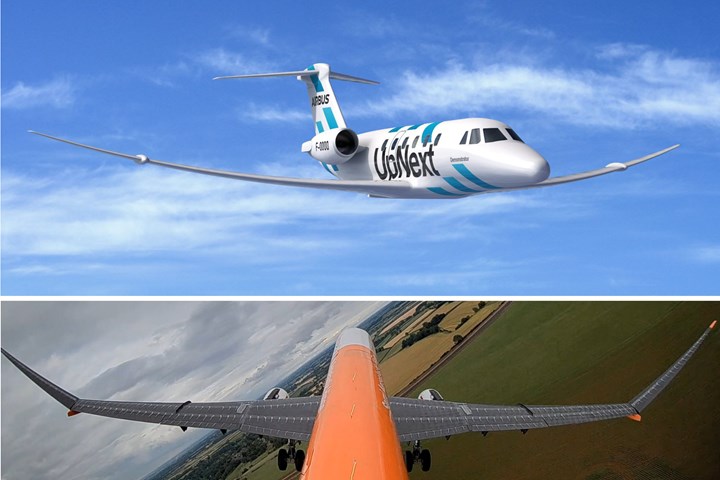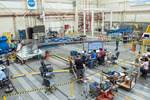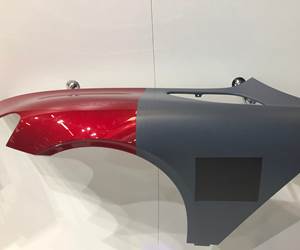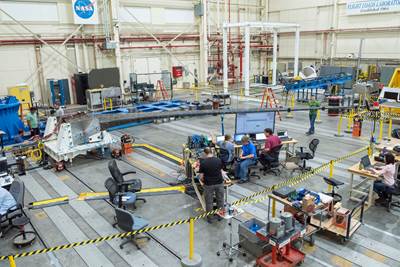Airbus X-Wing will test flapping wing tips, multifunctional trailing edges for future aircraft
Demonstrator will test 30%-scale version of 52-meter composite wing with electrically-powered actuating hinged wing tip for improved efficiency and decarbonization in flight.

(Top) Cessna Citation VII with artist rendering of extra-performing wings. (Bottom) AlbatrossONE demonstrator with hinged composite wing. Photo Credit: Airbus
Airbus has announced what it calls “an extra-performing wing demonstrator” that will accelerate and validate technologies to improve and optimize the wing aerodynamics and performance for future aircraft. Similar to how an eagle soars — adapting the shape, span and surface of its wings and feathers — this “extra-performing wing demonstrator” will enable increased flight efficiency. Various technologies will be investigated to allow for active control of the wing including: multifunctional trailing edges that dynamically change wing surface in flight, pop-up spoilers or plates that are rapidly deflected perpendicular to airflow, gust sensors and a semi-aeroelastic hinge.
The semi-aeroelastic hinge can be locked and unlocked to freely flap in flight, explains Aviation Week editors Graham Warwick and Guy Norris in their Sept. 20 article, “Airbus X-Plane Will Test Inflight Folding Wingtips.” The promise of this technology, they report, was shown in 2019-20 flights of a sub-scale unmanned model, the AlbatrossONE, that was developed by Airbus U.K. (See “Airbus Albatross flapping wing achieves gate-to-gate demonstration” and video below). Following the success of AlbatrossONE, the “extra-performing wing demonstrator” program has moved forward and will now proceed with another scaled demonstrator, a Cessna Citation VII business jet, that will be used to integrate and fly the above breakthrough wing technologies in representative flight conditions.
According to a September 2021 article by Jon Ostrower in the online publication, The Air Current, the “extra-performing wing demonstrator” program is known as X-Wing. Subtitled “Pulling the wings off of a bizjet in search of the technologies for Airbus’ next airplane,” the article explains that when Airbus pulled the plug on the E-Fan X demonstrator, most of the technical leaders for that project moved to X-Wing. It asserts that X-Wing will have far-reaching implications for Airbus’ next generation of airplanes as well as its continued competition with Boeing. Reportedly, those involved in X-Wing say the building blocks being demonstrated will serve as the basis for Airbus making future technology choices in 2025, leading to either a major incremental update to an existing platform or a completely new clean-sheet design.
According to a Sept. 22 Airbus press release, applications of the extra-performing wing would be compatible with any propulsion solution and aircraft configuration and would reduce CO2 emissions, contributing greatly to Airbus’ decarbonization roadmap. It also reports that this new demonstrator is hosted within Airbus UpNext, a wholly-owned Airbus subsidiary created to fast-track development of future technologies. It does this by building demonstrators at speed and scale to evaluate, mature and validate potential new products and services that encompass radical technological breakthroughs.
Why flapping wings?
A flapping wing would certainly be classified as a technological breakthrough, but what is the benefit? As explained by The Air Current article, finding the next big jump in aircraft efficiency — to reduce fuel burn and emissions — has become ever more complex and expensive. The low-hanging fruit has been picked. Longer wings, however, would reduce aerodynamic drag at cruise speed. The downside is potential inability to use existing airport gates. Enter folding wingtips. For example, explain Warwick and Norris from Aviation Week, the Boeing 777X, currently in development, will feature folding wingtips. Airbus’ X-Wing, however, is going further, developing the folding wingtips not just for ground use but also for flight.
Warwick and Norris give an in-depth primer on the history behind X-Wing, starting with AlbatrossONE. This was a 1/14th-scale radio-control model of an A321, which has a 52-meter-span wing, giving the electric-powered model a roughly four-meter wing span. It was devised to demonstrate that freely flapping wings were possible, allowing for load alleviation during flapping mode, and that such wingtips could be recovered for necessary control. The project was named after the albatross because the long-soaring bird has a sheet of tendons that allows it to lock its shoulder and keep its wing outstretched for an extended time without using its muscles. To flap its wing, the albatross unlocks its shoulder. The X-Wing’s semi-aeroelastic hinge provides the same type of efficiency.
AlbatrossONE flights in early 2019, before the folding mechanism of the semi-aeroelastic hinge had been manufactured, showed bending moments that did indeed provide the anticipated load alleviation benefit of allowing the wingtips to freely flap. Successive flights with the folding wingtips showed they were statically and dynamically stable throughout the flight.
Warwick and Norris report that X-Wing is now aimed at testing a 30%-scale version of a 52-meter-span wing with a moveable wing tip for potential application to a single-aisle airliner. The moveable tip section on the Cessna Citation VII demonstrator will reportedly be 2 meters long, compared to 2.4 meters for the current A320 “sharklet” winglet. The wingtip will be attached to the end of a high-aspect-ratio composite test wing via an electrically powered actuating hinge mechanism that incorporates a drive gearbox and clutch. The composite test wing helps to reduce weight — another issue with longer wings. The 777X will indeed use an all-carbon fiber-reinforced composite wing.
The moveable wing tip system on the X-Wing Citation VII demonstrator will operate in two main modes, explain Warwick and Norris. “In the first, the electric motor will drive the gearbox to position the wingtip to specific angles for various flight modes as well as takeoff and landing. The second mode, which involves declutching the drive mechanism, will enable the wingtip to move freely on its semi-aeroelastic hinge. The hinge system will receive position commands from the flight control computer to move the tip in various degree increments up and down, or to disengage the clutch. Flight tests with the flapping wing section are targeted to begin in late 2023.”
Warwick and Norris go on to describe how the folding wingtips work in detail, including blow-by-flow from gate to takeoff to landing, and quotes from Tom Wilson, semi-aeroelastic hinge project leader, and James Kirk, AlbatrossONE chief engineer, at Airbus UK in Filton, U.K. The two gave a briefing on the technology and its progress at the American Institute of Aeronautics and Astronautics’ virtual SciTech 2021 conference in January.
One interesting section of the Warwick and Norris article is how the gust sensors are a key piece of the flapping wing tip performance. Here, they quote Tom Wilson:
“We have to detect the gust on the nose of the aircraft, and then there’s a race. We have to send the signal from the detection sensor to the hinge to release the wingtip before the gust arrives on the wing,” Wilson said. “It’s a question of a few hundred milliseconds. The release system has to be very quick.” After the gust or maneuver, the wingtips are locked and recovered to continue efficient flight.
Airbus moving forward
“Airbus’ extra-performing wing demonstrator is another example of Airbus’ novel technology-oriented solutions to decarbonize the aviation sector,” says Sabine Klauke, Airbus chief technical officer. “Airbus is continuously investigating parallel and complementary solutions such as infrastructure, flight operations and aircraft structure. With this demonstrator, we will make significant strides in active control technology through research and applied testing of various technologies inspired by biomimicry.”
For a glimpse of the technologies that Airbus is developing now, watch the videos of Day 1 and Day 2 of the Airbus Summit 2021. Below is the Day 2 video starting with Clean Sky 2 programs that include composites and right before Sabine Klauke describes the “Wing of Tomorrow” and X-Wing programs.
Related Content
ASCEND program update: Designing next-gen, high-rate auto and aerospace composites
GKN Aerospace, McLaren Automotive and U.K.-based partners share goals and progress aiming at high-rate, Industry 4.0-enabled, sustainable materials and processes.
Read MoreNext-generation airship design enabled by modern composites
LTA Research’s proof-of-concept Pathfinder 1 modernizes a fully rigid airship design with a largely carbon fiber composite frame. R&D has already begun on higher volume, more automated manufacturing for the future.
Read MoreThe state of recycled carbon fiber
As the need for carbon fiber rises, can recycling fill the gap?
Read MorePlant tour: Joby Aviation, Marina, Calif., U.S.
As the advanced air mobility market begins to take shape, market leader Joby Aviation works to industrialize composites manufacturing for its first-generation, composites-intensive, all-electric air taxi.
Read MoreRead Next
Tow steering, Part 2: The next generation
Wings on next-generation commercial aircraft will be longer, thinner, more aerodynamic and more efficient. They also are ideal candidates for the application of steered tows. One project aimed to design, fabricate and quantify a tow-steered wing skin.
Read MoreModeling and characterization of crushable composite structures
How the predictive tool “CZone” is applied to simulate the axial crushing response of composites, providing valuable insights into their use for motorsport applications.
Read MorePlant tour: A&P, Cincinnati, OH
A&P has made a name for itself as a braider, but the depth and breadth of its technical aptitude comes into sharp focus with a peek behind usually closed doors.
Read More


















.jpg;maxWidth=300;quality=90)











